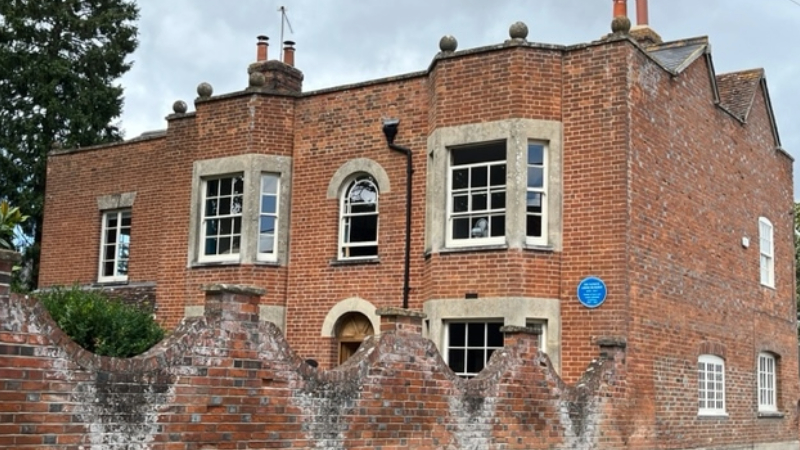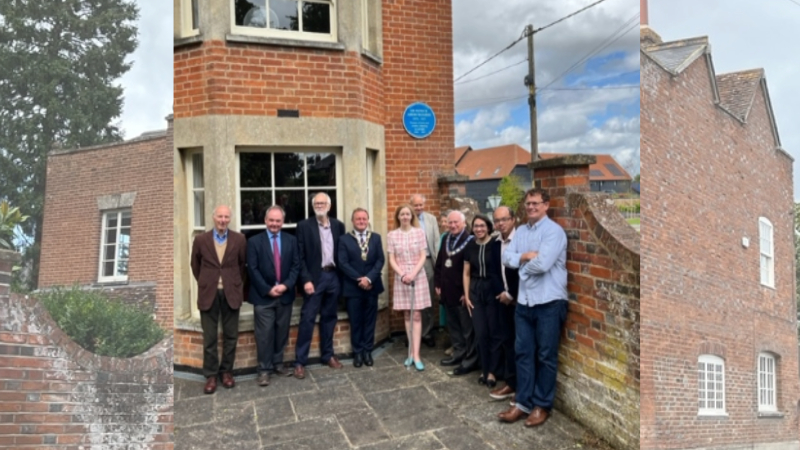Blue plaque honours the planning pioneer whose name adorns two schools at Oxford Brookes University

A blue plaque has been unveiled at the former home of Sir Patrick Abercrombie - a pioneer of town planning whose name was adopted for the building that houses the Schools of Built Environment and Architecture at Oxford Brookes University.
The late Sir Patrick lived in Red House, Moreton Road, Aston Upthorpe. The blue plaque was unveiled in a ceremony on Saturday 15 July by Professor Stephen Ward, professor of planning history from Oxford Brookes University. 
Professor Ward said: “When he moved here, into the Red House during the Second World War, Abercrombie had already become the foremost British town and country planner of his generation. During the years he lived here, right until his death in 1957, his renown largely endured and even grew further, especially internationally.
“His professional achievements had begun even before the First World War. He gained what was called a research lectureship at Britain’s first School of Planning, at the University of Liverpool.”
Professor Ward described how Abercrombie’s early consultancy work included a plan for Dublin he worked on with two other architects which came first in a town planning contest in 1914.
Professor Ward said: “By the 1940s, he was already recognised as a leading planning figure. But it was his two wartime plans for London and its wider region that fully cemented that reputation. These plans brought together all the key parts of his thinking about planning. They tackled major problems like bad housing, overcrowding, traffic congestion, urban sprawl and the loss of countryside around London.
“Abercrombie’s proposals were a mixture of complete clearance of the worst slums, protecting what was good from London’s past development, and carefully controlling and shaping how it should expand in the future.”
Professor Ward said Abercrombie was also passionate about the need to protect the countryside. He said: “In the 1920s he was a key figure behind what was originally called the Council for the Preservation of Rural England. It’s now, with the same initials, the Campaign to Protect Rural England.
“One of the main reasons why Abercrombie became such a central figure in planning was that, more than anyone else, I think, he brought together all the main strands of what British planning was about.”
Abercrombie was featured in these contemporary films about the replanning of London and Plymouth:
Proud City: A Plan for London (from approximately 6 minutes 50 seconds into the film to around 15 minutes)
The Way We Live (from approximately 26 minutes 15 seconds into the film to 39 minutes 15 seconds)
Photograph: At the Red House, from left are John Harwood, President, Oxford CPRE, Cllr Andy Foulsham, Vale of White Horse District Council, Professor Stephen Ward, School of the Built Environment, Oxford Brookes University, Cllr Felix Bloomfield, Chair, Oxfordshire County Council, Anna Shute, Director of Shute Consulting and Trustee of CPRE The countryside charity, Robert Evans, Chairman of the Oxfordshire Blue Plaques Board, Dr Elizabeth Poskitt, Deputy Chair, West Oxfordshire District Council, Cllr David Turner, Chair, South Oxfordshire District Council, Joney Ramirez, Royal Town Planning Institute South East, Mr Tsz Lok Ng (Jeffrey),Young Planner Trustee RTPI, Gavin Wood, current owner of Red House.
